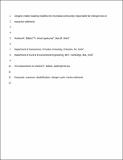| dc.contributor.author | Babbin, Andrew R. | |
| dc.contributor.author | Jayakumar, Amal | |
| dc.contributor.author | Ward, Bess B. | |
| dc.date.accessioned | 2016-06-27T20:33:24Z | |
| dc.date.available | 2017-03-01T16:14:47Z | |
| dc.date.issued | 2015-10 | |
| dc.date.submitted | 2015-06 | |
| dc.identifier.issn | 0095-3628 | |
| dc.identifier.issn | 1432-184X | |
| dc.identifier.uri | http://hdl.handle.net/1721.1/103364 | |
| dc.description.abstract | Coastal marine sediments, as locations of substantial fixed nitrogen loss, are very important to the nitrogen budget and to the primary productivity of the oceans. Coastal sediment systems are also highly dynamic and subject to periodic natural and anthropogenic organic substrate additions. The response to organic matter by the microbial community involved in nitrogen loss processes was evaluated using mesocosms of Chesapeake Bay sediments. Over the course of a 50-day incubation, rates of anammox and denitrification were measured weekly using 15N tracer incubations, and samples were collected for genetic analysis. Rates of both nitrogen loss processes and gene abundances associated with them corresponded loosely, probably because heterogeneities in sediments obscured a clear relationship. The rates of denitrification were stimulated more, and the fraction of nitrogen loss attributed to anammox slightly reduced, by the higher organic matter addition. Furthermore, the large organic matter pulse drove a significant and rapid shift in the denitrifier community composition as determined using a nirS microarray, indicating that the diversity of these organisms plays an essential role in responding to anthropogenic inputs. We also suggest that the proportion of nitrogen loss due to anammox in these coastal estuarine sediments may be underestimated due to temporal dynamics as well as from methodological artifacts related to conventional sediment slurry incubation approaches. | en_US |
| dc.description.sponsorship | United States. Dept. of Defense (National Defense Science and Engineering Graduate Fellowship) | en_US |
| dc.description.sponsorship | Princeton Environmental Institute (Siebel Energy Grand Challenges Initiative) | en_US |
| dc.description.sponsorship | National Science Foundation (U.S.) (NSF postdoctoral fellowship, #1402109) | en_US |
| dc.publisher | Springer US | en_US |
| dc.relation.isversionof | http://dx.doi.org/10.1007/s00248-015-0693-5 | en_US |
| dc.rights | Article is made available in accordance with the publisher's policy and may be subject to US copyright law. Please refer to the publisher's site for terms of use. | en_US |
| dc.source | Springer US | en_US |
| dc.title | Organic Matter Loading Modifies the Microbial Community Responsible for Nitrogen Loss in Estuarine Sediments | en_US |
| dc.type | Article | en_US |
| dc.identifier.citation | Babbin, Andrew R., Amal Jayakumar, and Bess B. Ward. "Organic Matter Loading Modifies the Microbial Community Responsible for Nitrogen Loss in Estuarine Sediments." Microbial Ecology 71:3 (April 2016), pp.555-565. | en_US |
| dc.contributor.department | Massachusetts Institute of Technology. Department of Civil and Environmental Engineering | en_US |
| dc.contributor.mitauthor | Babbin, Andrew R. | en_US |
| dc.relation.journal | Microbial Ecology | en_US |
| dc.eprint.version | Author's final manuscript | en_US |
| dc.type.uri | http://purl.org/eprint/type/JournalArticle | en_US |
| eprint.status | http://purl.org/eprint/status/PeerReviewed | en_US |
| dc.date.updated | 2016-05-23T12:14:06Z | |
| dc.language.rfc3066 | en | |
| dc.rights.holder | Springer Science+Business Media New York | |
| dspace.orderedauthors | Babbin, Andrew R.; Jayakumar, Amal; Ward, Bess B. | en_US |
| dspace.embargo.terms | N | en |
| dc.identifier.orcid | https://orcid.org/0000-0002-5046-0609 | |
| mit.license | PUBLISHER_POLICY | en_US |
